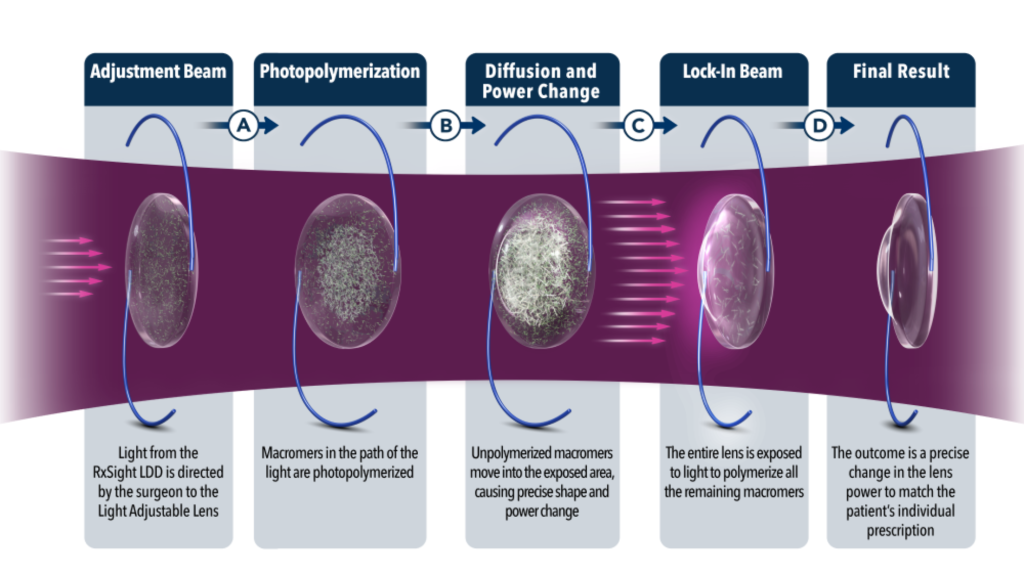When you have cataract surgery, it involves removing the natural lens of your eye. Part of the frustration that comes from having cataracts is the fact that your vision is no longer clear.
But when you have cataract surgery, an artificial lens replaces your natural lens. This ensures that you can see clearly after you’ve had your cataracts removed. The artificial lens is called an intraocular lens, or IOL.
These intraocular lenses help you see as well as you did with your natural lens. If you choose a premium lens, they can even provide you with better vision. For many people, when they choose an IOL, they end up with the best sight of their life, even before they had cataracts.
Each year, more and more advanced IOLs enter the market. It seems like every IOL has an increasing amount of new and impressive features.
But one premium IOL may be the most impressive: the Light Adjustable Lens. Keep reading to learn everything you need to know about the Light Adjustable Lens!
What is the Light Adjustable Lens?

The Light Adjustable Lens is a unique IOL that offers patients truly customized vision after they’ve had cataract surgery. How is this possible?
As the name suggests, the Light Adjustable Lens is the first and only intraocular lens you can customize after cataract surgery. It’s adjustable through the use of ultraviolet light treatments.
But this lens isn’t customized before you have it put in your eye. Instead, you’ll have the lens adjusted after your eye has healed after having cataract surgery.
This is the only intraocular lens that allows you to customize your vision after you’ve had cataract surgery. With other IOLs, the only way to change your vision after the procedure is to have the IOL removed or replaced. This is quite uncommon.
So what does all of this information mean for patients? Because you can have the Light Adjustable Lens adjusted after healing from cataract surgery, it means more accurate results.
This makes it more precise, especially if you compare it to other IOLs. Choosing an IOL before having cataract surgery involves a certain amount of guesswork.
When you have cataracts, your eye doctor can only estimate the prescription for your IOL before implanting it. This is harder to do when you have cataracts because your vision is distorted, blurry, or cloudy.
But with the Light Adjustable Lens, you take guesswork completely out of the equation. You’ll have the lens adjusted to fit your eyes after cataract removal and you’ve finished healing. This makes the results more precise, and more importantly, leads to better vision outcomes after you have cataract surgery.
How Does the Light Adjustable Lens Work?

You’ll have the Light Adjustable Lens placed into your eye during cataract surgery after your surgeon removes the natural lens. After lens placement, your eye will be given time to heal on its own.
During the time that your eye heals, you will need to wear protective glasses at all times. These glasses keep your eyes from getting any kind of exposure to UV light.
You can only take them off when you’re showering, sleeping, washing your face, or applying eye drops. If you come into exposure with any direct sunlight, you must wear these glasses.
These glasses prevent the lens from adjusting its shape before your eyes finish healing. After healing, your eye doctor will give you a visual acuity test.
What is a Light Delivery Device?
They will also show you different visual options to determine the best prescription. After determining this, you’ll start receiving light treatments with a Light Delivery Device (LDD). The LDD uses ultraviolet light to adjust the lens to your exact prescription and change the shape of the lens to fit your prescription.
To make sure you achieve the best possible vision, you’ll need to undergo several light treatment sessions. These take place at your eye doctor’s office. They require you to look into the Light Delivery Device for about 90 seconds.
There’s no need for further surgery or any other form of invasive treatment. The treatment sessions take place three days apart.
Most patients usually need 2 or 3 sessions each. How many sessions that you need to have will depend on your unique prescription.
Undergoing several light treatment sessions ensures that your IOL is precisely shaped to your exact prescription. This will continue to be the case even as your eye may continue to heal in the weeks following having cataract surgery.
Between these sessions, you will need to continue wearing your protective glasses at all times during the day. Once you’ve completed your light treatment sessions, you’ll have the vision that you’ve always wanted.
The best part? You won’t need any more light treatments! Your final prescription gets locked in so you won’t have to worry about having the lens adjusted later on.
Who is a Good Candidate For the Light Adjustable Lens?

The Light Adjustable Lens, along with the Light Delivery Device is for patients with cataracts that need surgery to remove them. Another advantage of the Light Adjustable Lens is that it’s for patients with astigmatism that’s at least 0.75 diopters.
There are plenty of other intraocular lens options for people with astigmatism. The most common of these are toric lenses. Only toric lenses are specifically for people with astigmatism.
Toric IOLs accommodate the abnormal, football-like shape of the eye caused by astigmatism. A toric IOL will align and compensate for whatever degree of astigmatism a patient may have.
The Light Adjustable Lens brings a new level of accuracy that other lenses don’t. With the technology used during the light treatments, you can have your vision adjusted to your precise prescription. This is more accurate than the prescription that your eye doctor measures before you have your cataracts removed.
If you have astigmatism and want the most out of cataract surgery, the Light Adjustable Lens may be the right IOL for you!
Patients that may not be a good fit for the Light Adjustable Lens include:
- If you’re taking medications that make you more sensitive to UV light
- You’re on medication that may be harmful to your retina
- If you have a history of eye infections, herpes, or uncontrollable eye movements, known as nystagmus
- You can’t follow the schedule for LDD light treatments
- You are unable to wear the UV-protective glasses after having cataract surgery
The only way to know if the Light Adjustable Lens is right for you is to schedule a cataract screening at Loden Vision Centers in Nashville, TN! Why wait if you’re tired of living with cataracts?


